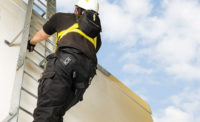“People only see what they are prepared to see.” — Ralph Waldo Emerson
You’re having a short morning session with employees from maintenance. “Today I’m asking for your help in finding hazards and OSHA violations. Look around and jot down on the Hazard Hunt form any problems you see; anything you feel is a hazard. Seeing is so important to safety. Return the forms to me and we’ll go over your list.”
You don’t want your people fanning out across the floor, seeing only what they’re prepared to see. But have you trained them in seeing – how to really see?
I attended a two-day workshop recently where a class of safety professionals were asked this question. No hands went up.
“What are you going to do for an 18- to 23-year-old who yesterday worked at Wendy’s and today will be walking into a high-risk work environment?” asked Mike Deetsch. Mike is not a safety trainer, He’s the director of education and engagement for the Toledo Museum of Art, where this workshop was held.
A novel approach
What are ten safety pros doing listening to an art educator at a museum? Next door, a group of employees from a Thyssenkrupp plant are also getting an education in visual literacy. For two, full, fast-paced days attendees study photographs projected on a screen, draw their notion of what “safety” means, and spend a few hours in front of paintings and sculptures in the museum’s 366,732 square feet of gallery space, learning the difference between “looking” and “seeing” and the importance of communicating what you see.
“Each of our team members can improve their ability to recognize hazards and do something about risk reduction,” says Chuck Baumgartner, EHS Group Leader for NSG –Pilkington North America, Inc. in Rossford, Ohio. “The concepts of learning to see and the elements of art can be applied to our hazard recognition and incident investigation process.” Why was Chuck at the workshop? “I’m always interested in new and improved ways to grow our safety capability.”
This workshop on visual literacy is one of many organized by the Center for Visual Expertise – COVE – founded in 2018. Speakers are a mix of EHS professionals from industry, such as Doug Pontsler, former VP of operations, sustainability and EHS for Owens Corning, and art educators from the museum, such as Mike Deetsch.
Being proactive
Visual literacy is not a program, not a one-off training session, but a set of skills – visual competencies that can be developed and honed. Critical thinking is at its core. Thinking -- recognizing and anticipating hazards and developing an inventory of prioritized risks -- is fundamental to proactive safety.
Visual literacy requires first looking at a work environment or incident scene (akin to skimming or scanning). Digging deeper, you then observe – active engagement requiring time and attention. Slowing down. Next in this skill set is seeing. Seeing is not looking. It is creating a mental inventory of all of an image’s visual elements. That image can be the work environment in all its complexity.
This attention to detail can be easily and often overlooked if employees tune out surroundings and conditions they’ve work in for years. They become de-sensitized, complacent, selectively attentive, and work using tunnel vision. Biases and blind spots develop. Bottom line: we fool ourselves. We don’t see as well as we think we do.
It’s not enough to see; you must be able to describe what you observe. Visual literacy uses the elements of art – color, line, shape, space and texture – to create a common language for describing to others what you see. Your description, or report of hazards identified, involves analysis and interpretation. Description – communication -- and analysis and interpretation are components of visual literacy.
Slowing down
In the workshop, safety pros huddled around large paintings in the gallery, pointing out colors, lines, spacing, shapes and textures. They learned to move their eyes from the painting’s perimeter to its interior. They looked for contrasts; looked at different angles to change their perspective and point of view. Some twisted their heads to look at the painting upside down. They slowed down and repeatedly looked at the scene. (The average museum visitor spends only 17 seconds studying a piece of art before moving on.) Then workshop participants explained to the group what they saw, and discussed the various biases that could distort or blind them to their interpretation.
Employees can go on hazard hunts and use visual literacy skills to observe and describe housekeeping, work flows, ergonomic issues, work at height, equipment operation and maintenance. Lines, spacing, colors, shapes and textures come into play. Stairwell treads may be worn down (texture). Warning sign colors might be faded. Work flows do not allow for adequate spacing. Housekeeping is disorderly and out of alignment. Confined space entry can be obstructed by the shape of objects in the space.
Employee engagement is essential for effective hazard recognition and incident investigation. Safety professionals cannot be everywhere, watching everything. Use the “power of the collective,” as the museum’s Mike Deetch calls it. Front line veterans are in the best position to recognize when, where and how the next accident will happen. But you need their buy-in for a visually literate workforce. Twenty-, thirty- and forty-year vets will cross their arms and tell you they’ve seen it all, know the risks, and don’t need an art education.
But visual literacy is not an exercise in “death by PowerPoint.” Training is interactive. Enlarged real-world photographs of worksites are dissected, turned upside down, viewed from different angles. Participants pair off to stand back-to-back in front of an art object, taking turns as one describes the piece of art and the other draws it without seeing it, based solely on how it’s described.
Catching on
Owens Corning, based in Toledo, wanted to improve the hazard recognition competencies of its employees and partnered with the Toledo Museum of Art, which was teaching visual literacy to staff and schools. More than 300 Owens Corning staff and volunteers participated in a 2015 pilot project. Today the company certifies workers as hazard recognition and control specialists. Cummins, headquartered in Columbus, Indiana, has rolled out visual literacy training to distribution and manufacturing sites and plans on taking it worldwide. One Cummins plant reported 60 percent of its recordable injuries were due to a lack of hazard recognition, particularly among new hires and temporary employees. COVE recently put Disney employees through the visual literacy workshop in Orlando.
An increasing number of organizations are investing in visual literacy for several reasons. One, we live in a world of daily, hourly, minute-by-minute visual saturation bombing. Ninety percent of the information we take in is through our vision. It’s estimated that on average we consume 11 hours of electronic media daily, compared to 24 minutes reading print media.
Second, visual literacy can be applied to hazard hunts, compliance checks, hazard mapping, job safety/hazard analyses, mobile device auditing and reporting, fault tree analysis, hazard and operability analysis, failure mode and effects analysis – hazard recognition formats of all sorts.
Its benefits extend beyond recognizing, prioritizing and fixing hazards. The skills learned can reduce errors, identify gaps in your safety program, improve observations such as used in behavior-based safety, increase employee engagement, and improve incident analyses. Beyond safety, visual literacy sharpens decision-making and analytical thinking, improves communication, builds teamwork, invigorates organizational cultures, and can be applied to quality, production and other operations.
|
Decreasing risk tolerance; Increasing risk recognition Research by the Campbell Institute, a center of excellence at the National Safety Council, is tracking visual literacy training at pilot sites of a number of institute member companies, according to Joy Inouye, an institute research associate. One site with the most mature implementation has seen noticeable improvement in how workers perceive hazards and risk. Their tolerance for risk has decreased and their ability to recognize hazards has increased, according to Inouye. This site has identified more than 100 issues using the elements of visual literacy and submitted and corrected dozens of hazards using skills learned in visual literacy training, she says. The Campbell Institute has plans to explore connections between visual literacy and human performance/human factors, neuroscience, and serious injury and fatality prevention. |



